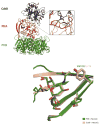Emerging insights into the biology of typhoid toxin
- PMID: 28213043
- PMCID: PMC5484737
- DOI: 10.1016/j.mib.2017.01.012
Emerging insights into the biology of typhoid toxin
Abstract
Typhoid toxin is a unique A2B5 exotoxin and an important virulence factor for Salmonella Typhi, the cause of typhoid fever. In the decade since its initial discovery, great strides have been made in deciphering the unusual biological program of this toxin, which is fundamentally different from related toxins in many ways. Purified typhoid toxin administered to laboratory animals causes many of the symptoms of typhoid fever, suggesting that typhoid toxin is a central factor in this disease. Further advances in understanding the biology of this toxin will help guide the development of badly needed diagnostics and therapeutic interventions that target this toxin to detect, prevent or treat typhoid fever.
Copyright © 2017 Elsevier Ltd. All rights reserved.
Figures


References
-
- House D, Bishop A, Parry C, Dougan G, Wain J. Typhoid fever: pathogenesis and disease. Curr Opin Infect Dis. 2001;14:573–578. - PubMed
-
- Haghjoo E, Galan JE. Salmonella typhi encodes a functional cytolethal distending toxin that is delivered into host cells by a bacterial-internalization pathway. Proc Natl Acad Sci U S A. 2004;101:4614–4619. This study first demonstrated that S. Typhi is a toxigenic pathogen. It demonstates that S. Typhi-infected cells are intoxicated by CdtB and that this toxin is exclusively produced following infection by intracellular S. Typhi. - PMC - PubMed
-
- Spano S, Ugalde JE, Galan JE. Delivery of a Salmonella Typhi exotoxin from a host intracellular compartment. Cell Host Microbe. 2008;3:30–38. This study represents the discovery of typhoid toxin. It identifies the three subunits of the toxin, demonstrates their assembly and, importantly, illustrates the unusual autocrine/paracrine delivery mechanism of typhoid toxin. - PubMed
-
- Lara-Tejero M, Galan JE. Cytolethal distending toxin: limited damage as a strategy to modulate cellular functions. Trends Microbiol. 2002;10:147–152. - PubMed
Publication types
MeSH terms
Substances
Grants and funding
LinkOut - more resources
Full Text Sources
Other Literature Sources

